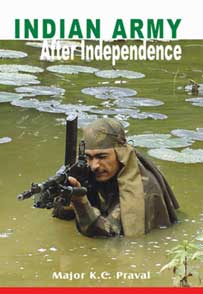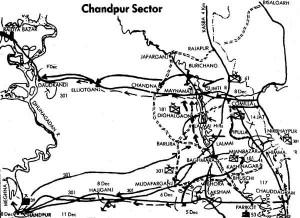“¦they had not neglected the defences of Laksham and Comilla, which stood on the route to Dacca. Between Comilla, the main city in the region, and Laksham, was a string of hillocks called the Lalmai Hills.
They dominated Laksham and the Pakistanis had fortified them. On the Northern tip of the Lalmai Hills stood the cantonment of Maynamati. Both Laksham and Maynamati had been turned into fortresses and it would have been costly to reduce them and then advance to Chandpur, the main objective of 23 Division. Infiltration between the Lalmai Hills and Laksham was therefore decided upon.
The force selected for this task was 301 Mountain Brigade under Brigadier Harinder Singh Sodhi which had a squadron of PT-76 tanks under command. Simultaneously, 83 Mountain Brigade; commanded by Brigadier B.S. Sandhu, was to isolate Laksham from the South, while 181 Mountain Brigade under Brigadier Y.C. Bakshi, was to follow 301 Brigade and cut off Laksham from the North and West. While these moves were afoot, 61 Brigade led by Brigadier pande, was to keep the Pakistanis at Maynamati occupied and also make a bid for Daudkandi.
Led by 14 Jat, 301 Brigade began to move in soon after dusk on 3 December. The brigade made good progress. In fact, during this initial operation it received the first large surrender of the campaign. Two companies of 25 Frontier Force were holding the Mian Bazar area, South of Comilla. After Sodhi had cleared Mian Bazar on 4 December, they began to pull back to their layback positions further West. To their dismay they discovered that 1/11 Gorkha Rifles had already occupied them. Trapped, they were forced to surrender. The bag included the battalion commander, five of his officers, eight JCOs and 202 other ranks.
By first light on 5 December, 181 Brigade had cut the road and railway-line between Laksham and Lalmai and blocked Laksham from the West. This helped Sodhi and in a surprise move, he took Mudafarganj the next day, with the bridge over the Dakatia intact. His 1/11 Gorkhas had infiltrated during the previous night, moving manpack, each person carrying between 30 and 35 kilograms of equipment.The enemy was sensitive about Mudafarganj. About ten kilometres North-West of Laksham, the town lay on the main route to Chandpur. General Khan decided to recapture it. He had come to know of the loss accidentally. On the afternoon of 6 December he was on his way from Chandpur to personally organize the defence of Laksham. When his party neared Mudafarganj it came under fire; the Gorkhas seized the pilot jeep, though his own vehicle managed to turn and escape.
Click to buy: Indian Army After Independence
By this time the enemy 53 Brigade had withdrawn to Laksham after a mauling by Sandhu’s 83 Brigade. Two Pakistani columns set out from Laksham on 7 December to retake Mudafarganj. Each had two to three companies of infantry under a lieutenant colonel who were to attack their objective from different directions. Around 2300 hours that night one of the columns (15 Baluch) reached Mudafarganj. By then only two companies of 1/11 Gorkha Rifles were left there, as Sodhi had set out for Hajiganj during the evening with their remaining companies and 3 Kumaon.
The enemy was sensitive about Mudafarganj. About ten kilometres North-West of Laksham, the town lay on the main route to Chandpur.
The Gorkhas at Mudafarganj had no mines or wire for their defences but they battled with the Pakistanis for four hours and succeeded in repelling them. The second column (two companies of 23 Punjab [Pakistan] and one company of Azad Kashmir troops) failed to show up—it had got embroiled with the Mukti Bahini on the way.
After the action at Mudafarganj the Baluch companies were called back to Laksham while the second column was ordered to Hajiganj. The two colonels were now with that column and they decided to move cross-country and hit Hajiganj from a flank, not realizing that 301 Brigade would get there earlier, moving by road. Sodhi entered Hajiganj on 8 December, his troop getting a rousing welcome from its people. The town had been taken during the morning by 3 Kumaon after a brisk action. The Pakistani column reached the town that night and was dispersed easily. Chandpur was also evacuated that night.
Meanwhile 14 Jat had taken Comilla. Responding to the pressure against Maynamati, the Pakistanis had mostly cleared out of the city, except for paramilitary personnel. The Jats happened to be in the Majlispur area, South-East of the Lalmai Hills on the morning of 7 December and General Hira ordered them to go and capture Comilla. They marched 30 kilometres to launch the attack. Begun at last light the operation was over by dawn on 8 December.A column of 61 Brigade, led initially by 2 Jat and later by 12 Kumaon, had been launched towards Daudkandi on 6 December. It had a troop of tanks in support but hardly any transport. Mules, porters and rickshaws were pressed into service and the column was able to take Chandna, 17 kilometres West of Comilla, the next day. After a sharp action at Elliotganj, the leading elements reached Daudkandi on the evening of 9 December. While this operation was under way, the rest of the brigade kept Maynamati engaged.
Most of them were keen to give themselves up, but not to the Mukti Bahini as they were very scared of it.
The Lalmai defences were seized on 8 December by a battalion of 181 Brigade. By then Laksham had been surrounded and was subjected to heavy-duty doses of shelling and air-strikes. The garrison became nervous and reacted to Indian jitter parties as if they were major attacks, firing wildly and wasting ammunition. On 9 December a rumour was set afloat that a full-scale attack on Laksham would be launched that night. At the same time the civil population of the villages to the North of the town was told to clear out. This touched off an exodus. The garrison split into columns and made for Maynamati during the night, taking only their personal arms along. A portion managed to reach their destination, but a large column, more than a thousand-strong, was rounded up three days later after it had tried to fight its way to Maynamati.
This cantonment now had two Pakistani brigadiers and a garrison numbering about 4,000, with a battery of guns and four tanks. After an attack by 7 Rajputana Rifles (61 Brigade) had established a foothold on the defences, 61 and 181 Brigades were ordered to capture the cantonment. However, Maynamati defied capture till the general surrender of 16 December.






